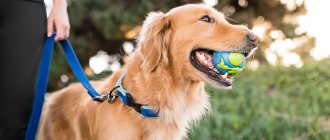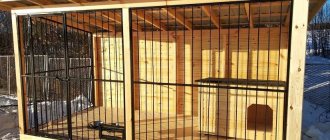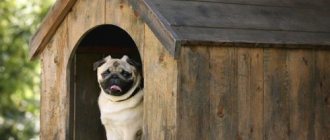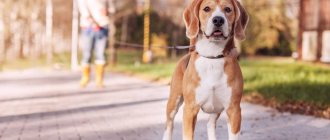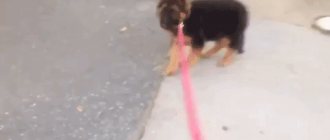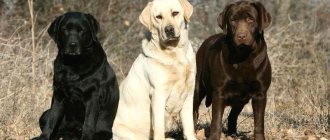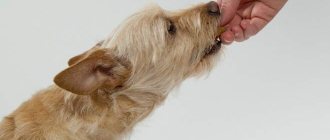Labrador is an amazing dog, full of strength and vitality. They are incredibly mobile, active and simply cannot imagine their life without people. Dogs are flexible, obedient and ready to put in a lot of effort to please their owner. It is for this reason that they are very easy to raise and train. But you need to start doing this from the moment the puppy appears in the house. How to instill in your pet the rules and norms of life, teach a Labrador to go outside or wear a diaper to the toilet , how to stop a Labrador from shitting at home - we’ll talk today.
Master's Code
A loyal friend, companion, assistant - that's all he is, a Labrador; caring for and keeping a representative of the breed at home can seem quite complicated. This is an active dog that needs to run around and splash out its energy. In addition, due to its considerable size, it consumes quite a lot of feed.
Labrador is an excellent companion and faithful friend for many years
For your information! Those owners who decide to stick to natural food will have to cook especially for the dog, and in large portions.
Before you make the final decision to become a Labrador Retriever owner, you should familiarize yourself with the following owner code:
- There are no bad dogs. There are unscrupulous and irresponsible owners;
- The standard life expectancy of dogs is 12-18 years. All this time he will need to be taken care of, walked every day, regardless of the weather and health;
- an animal is not a toy that you can get rid of after deciding that you are tired of it. This is a living creature with its own character and habits;
- it's important to be consistent. The cute antics of a puppy who loves to affectionately bite his owner’s legs will no longer be so touching as he grows up. Therefore, from early childhood, all prohibitions are practiced clearly. If you can’t, then you can’t forever;
- training and training should be carried out according to the principle from simple to complex. A “carrot and stick” policy without physical violence and aggression is the choice of a responsible owner. “Whip” in this case is a stern tone, a demonstration of displeasure;
- The dog's nutrition is the responsibility of the owner. A dog is not a pig, waste from the human table is not suitable. They either prepare it separately or buy ready-made industrial feed;
- The veterinarian is a specialist whom you will have to get to know. Preventive examinations should become a good habit. It is better to prevent any disease than to treat it.
These are the main points that a Labrador owner should consider.
The Labrador will become a true friend to its owner, but needs proper training
Common mistakes
- Strictly punish the puppy, instill in him a fear of his owner. A frightened animal learns worse.
- Beat the animal for puddles and heaps discovered after a while. In particularly advanced cases, such behavior of the owner leads to coprophagia - eating one's own excrement. It is very difficult to wean a dog from this.
- Select the wrong size tray, without taking into account physiological needs, too tight. An adult male dog will need a tray with a post.
- Do not keep the tray clean.
- It is inconsistent to punish a dog by “closing your eyes” every other time.
- Ignore praise.
- Forget about constant training. Even an adult, accustomed individual sometimes presents a surprise. Plus, dogs can forget where their toilet is if you don't spend enough time with the animal.
Command training
The commands “Sit”, “No/Fu”, “Lie down”, “Stand”, “Voice” - the Labrador begins to be taught at the age of 4-5 months. Moreover, you need to start with the first two commands. A small puppy should not be over-trained. He is not yet able to concentrate well, so 5-10 minutes will be enough for one training procedure. But you can make up to 5-6 such visits per day. After 9-12 months, you can exercise with a Labrador for up to 30 minutes, but 1-2 times a day.
Getting a puppy used to a diaper at 1 month
Prepare the apartment for the arrival of a new tenant: remove carpets, shoes and other items lying on the floor. If the surface is slippery, you will have to purchase a coating that will be easy for you to clean and you won’t mind throwing away when your baby grows up. Slippery floors can injure your dog's paws.
Cover the rest of the surface where the puppy will go to the toilet with diapers. By the age of one month, the baby still does not control the process, so he can pee and poop anywhere. There is no point in scolding him for this.
The first stage is just getting to know each other. It is not yet possible to accustom a one-month-old puppy to a diaper; there will still be mistakes.
Education and training
The Labrador puppy is charming and spontaneous; caring for him should begin from the first day.
Toilet training
Chihuahua: care and maintenance at home
Before the first vaccination, the baby should not be taken outside, and in general it is advisable to limit contact with other animals, even domestic ones. Therefore, it is better for the owner to buy a special diaper for puppies of medium and large breeds and accustom the puppy to it. Possible options:
- trace where exactly the baby prefers to make a puddle and lay a diaper there;
- observe the puppy, as soon as he takes a characteristic pose, quickly put him on the diaper.
Note! You cannot hit the puppy or shout at it, but you should praise and pet it for its success.
Outdoor toilet
Labradors are so smart that they very quickly understand what their owner wants from them. How to get used to walking:
- Choose a collar that is comfortable for the animal, put it on first at home and for a short time, then increase the duration. Such training can be carried out before vaccination to avoid wasting time.
- Always go out at the same hour during the first walk to morally support the puppy, because the street is now a stressful factor for him.
- Wait until the baby goes to the toilet and praise him for his success.
- Give the opportunity to frolic.
Accustoming to cleanliness
This is not an easy task, since representatives of the breed are fully formed by the age of 3, before which they can play around and behave unpredictably. It is important to sternly scold your Labrador for breaking house rules, and not laugh at his antics. The baby should be raised from the first days of life in an apartment or house.
Touching and cute Labrador puppies can captivate even the hardest heart
Accustoming to home environment
Moving to a new home for a Labrador puppy is extremely stressful. It is important to support him and pay special attention. You should not leave your baby alone, especially at night, you should talk to him, stroke him, and try to distract him. Many Labradors try to hide in a corner, and after a while they begin to examine the apartment. At this stage, you should not disturb them; the sooner they explore the place, the more calm they will feel.
Note! Dog handlers recommend getting a dog while on vacation. So the adaptation period will pass under the control of the owner.
Ways to train a Labrador to toilet outside
Labrador (the name is similar to the Portuguese “trabalhador” - worker) belongs to the elite breeds.
Its representatives are superior to most service and user dogs in terms of sense of smell, swimming ability, and memory capacity.
A high level of intelligence allows the Labrador to feel equal to any owner, although he prefers capable companions.
Psychologically, a dog from birth is determined to create and maintain partnerships with its owner.
Labrador is ready to understand a person at a glance - as long as he is able to clearly explain his requirements.
The dog knows how to adapt to a change of environment, in any conditions it feels proud and confident.
Labrador is an optimist and a healthy guy with a positive attitude.
The kind attitude of others is the norm for him; he himself treats them the same way. The dog tries to please the wishes of the owner.
There are several ways to train your Labrador to use the toilet outside.
Which one to choose depends on the age of the purchased puppy, its living conditions in the first days, the time of year, and the owner’s character traits.
Puppy and hygiene in the house
Cleanliness is an innate quality of any dog; Labrador is the rule rather than the exception.
If a three-week-old puppy, a fool, gets into the house, at first he will dirty the floors.
The frequency of incidents will reach five to seven per day.
It is unlikely that by this age the dog will have developed any stable behavioral skills.
It is still too early to take a puppy outside every time at this age: he simply will not “carry” all the “wealth” to the nearest garden bed.
One thing is clear: as soon as the baby learns to move a distance of 5–6 meters, he will tend to defecate outside the “den.”
Experts advise spreading several diapers or newspapers that absorb moisture at this distance from the puppy’s mat.
The need for a baby Labrador occurs after sleep, after eating and during play.
At first, the dog does everything very quickly and without prior preparation.
Therefore, breeders initially recommend that the puppy be moved to the toilet area five to fifteen minutes after waking up and finishing feeding.
It is better to fence off the dog’s habitat during this time.
If the puppy manages to poop somewhere in the middle of the room during play, he should not be punished: the puddle is wiped off with a newspaper and taken to the permanent toilet.
There the wet litter is hidden under the dry one. The crime scene is treated with a weak solution of vinegar, potassium permanganate or deodorant.
Basic rules of training
The owner must necessarily show his attitude towards the dog’s antics.
If she does the right thing, she needs to be encouraged, otherwise it would not be a bad idea to show her negative attitude.
The exclamation, however, should be short, sonorous, and memorable.
It is advisable to record a constant reaction to the command word in the puppy.
When the time comes for a walk, it may turn out that the dog knows the only place where it can go is the house toilet.
Often three- to six-month-old Labradors exhaust their owners; they refuse to urinate on the grass and prefer an apartment.
In order to avoid such psychological pressures as much as possible, the owner needs to try to ensure that the dog can balance its actions with the owner’s reaction.
It is advisable to remove wet newspapers in a timely manner, strive to control the process itself, and learn to react correctly.
If the time of year allows, the baby is taken out onto the grass after the first attempt to relieve himself.
Usually an adult dog needs to recover several times, a puppy can repeat the same action outside.
It is better to carry the baby with the belly up, supporting it under the croup.
Difficulties of adolescence
At three months the baby can be walked. A “walk” is not a “walk” where the puppy should frolic and play.
Walking is a targeted event; this understanding must be conveyed to the dog.
The exit schedule should remain the same as in early childhood: after waking up, ten minutes after eating, before bedtime.
It turns out that you need to make up to seven trips outside per day - for this you need to set aside an hour and a half of time.
In contrast to mischievous walks, walk the dog at a slow pace, giving it the opportunity to sniff those objects that it deems necessary.
At the same time, it is not out of place to say words that he remembered once, those that will prompt the baby to perform the necessary action.
You can take scraps of newspapers and household toiletries with you to place them in the right places.
A walk should end with a walk. After running around and playing with other dogs, the puppy is led on a leash to a familiar place and walked on a long leash.
The dog may simply get carried away and not remember the need to do important things.
How to punish a pet
Breeders advise using moderate violence no earlier than eight months.
Only the dog that is caught committing the crime should be punished.
It is advisable that a small puppy perceive punishment not as suppression of will, but as an instruction from an older comrade.
Shouting and slapping with some soft object - a rolled up newspaper, for example.
However, many experienced dog breeders claim that the Labrador is a very tactful dog. He always knows what the owner owes him at every moment.
The dog is not used to begging, whining, or humiliating himself.
A dog can remind you of its problems with a gaze that will not pass by the attention of a person interested in the dog.
Photo gallery
We hope you find this article useful. And now you, without much difficulty, will find mutual understanding with your little pet on this sensitive issue.
Video
We invite you to watch a video containing recommendations regarding training a Labrador puppy to relieve itself in a designated area in the apartment.
Useful tips
- Carefully choose the place and time for your first walk. It is advisable if it is an uncrowded, quiet place away from the roadway. If the area is located far from your home, it is better to carry the dog there in your arms for the first time so that the animal does not get scared and begin to get under the feet of passers-by.
- For the first time, do not plan long walks. to accustom a Labrador puppy to the street only gradually. Take into account seasonal and climatic features. should be calm and tired after a walk Fifteen minutes will be enough at first. Next, how long to walk your Labrador puppy depends on you. But, remember, your pet should breathe fresh air and run for a total of at least two hours a day.
- Gradually accustom and socialize the animal. You should not isolate him from other dogs. But be careful, danger can lurk in seemingly harmless things.
- Never let us “communicate” with stray dogs. At a minimum - fleas and serious illnesses. At the most, the dog can be bitten, or even tortured to death.
It is enough to follow these simple and simple rules, and your first walk will go with a bang. But you shouldn’t relax, because a long and difficult path awaits you on how to turn your pet into a well-mannered dog.
Creating a Safe Environment
Cocker spaniel: care and maintenance at home
Newbie owners are interested in what is needed for a Labrador in an apartment. First of all, this is its own place where the dog can relax and feel safe; you cannot punish or scold the pet in those moments when he is in place. Primary requirements:
- absence of drafts;
- choose a quiet place;
- Labrador should not interfere with the movement of its owners, so it is usually placed in a corner;
- It is better to lay an old sweater or some other piece of clothing on the floor, as the smell of the owner has a calming effect on the animal.
Important! You should also prepare bowls, diapers, toys, a collar and a leash in advance.
A small pet will quickly take root in a new home if you create all the conditions for it
Answer
By nature, the Labrador is not intended to live in a city apartment. Nature has created an impatient breed. Canine instincts allow the dog to send physiological needs immediately when a desire arises.
Of course, the owners are not happy with this state of affairs. Punishments begin in the form of poking one's nose into a puddle or pile. The trouble is that the puppy comes to completely different conclusions. Fearing punishment, the animal begins to eat the parcels in order to hide traces of the crime.
Dog character
In the third month, behavioral characteristics can be compared with those of teenagers. He considers his family to be his pack, studies the internal hierarchy and tries to determine his place.
The puppy becomes more independent and tries to show dominance . You may notice how he questions power and authority.
The puppy may chew on the stick and ignore commands, but his attention is focused on your reaction. Be steadfast, tolerant and gentle. Your actions must be consistent, and your commands must be reinforced.
If your puppy bites or growls while playing, stop the inappropriate behavior and ignore it for a few minutes..
Do not fight with the puppy under any circumstances. This will make it clear that the fight is good and fun. Your main task is to instill in the dog the concept of obedience.
If the puppy becomes overexcited and aggressive, stop interacting immediately..
How to understand that a pug wants to go to the toilet?
But how can you understand that a dog wants to go to the toilet if it doesn’t ask to go for a walk? ... If the dog does not ask to go outside, you should pay attention to the following signs:
- the pet is worried and cannot find a place for itself;
- actively sniffs the surrounding area;
- spins in one place;
- moves quickly from one corner to another.
Interesting materials:
How to share videos from Google Drive? How to prepare bean seeds for planting? How to prepare to meet your parents? How to feed starter in the refrigerator? How to starch tulle? How to increase FPS in CS GO on a weak laptop? How to increase Stories views on Instagram? How does the dough rise? How to choose a tie for a gray suit? How to choose shoes to match a jacket?
Maintenance in an apartment and private house
Keeping a Labrador in a private home involves building an enclosure and a comfortable kennel. This dog does not like to sit on a chain, so it is allowed to make it a pet with the possibility of walking.
Jack Russell Terrier: care and maintenance at home
Can be used as a guard dog; this is a very disciplined dog that will bark to warn of danger.
Possibility of being kept outdoors
The Labrador has a warm coat, so it can be kept outside if necessary. For this purpose, an enclosure and a booth are built; keeping a representative of the breed on a chain is unacceptable.
Note! Street keeping does not mean that the pet does not need a walk. You should walk with him at least once a day for an hour.
Photo gallery
We hope you find this article useful. And now you, without much difficulty, will find mutual understanding with your little pet on this sensitive issue.
Booth
The main building inside the enclosure is a doghouse. While inside the kennel, the dog should be able to stand upright and lie down with its paws extended. Therefore, its height and depth should be equal to the dog’s height plus 10-15 cm. If the size of the booth is smaller or larger than recommended, the Labrador in the first case is at risk of diseases of the bones and joints, in the second it will be difficult for him to stay warm in the winter.
Materials for the kennel should be natural, most often it is deciduous wood, because... Coniferous wood produces a sticky resin with a pronounced odor. The boards must be treated with a compound against fungus and rot. The paint covering the booth must be water-based. The roof can be of any shape, and for cleaning and disinfection inside it must be completely removed or folded down.
Labrador retrievers are a breed not adapted to severe frosts. If a Labrador lives in a kennel in winter, the owners need to take care that the animal does not freeze in winter. It is better to make a booth with double walls. Between them it is necessary to lay insulation - sawdust or polystyrene foam.
Hygiene and appearance care
Basic rules of care:
- wash once every six months or when heavily soiled;
- Trim nails once a week with a guillotine. If the dog is walked on a hard surface, the claws grind down on their own, and accordingly, their trimming is required less often;
- comb out every 3 days using a special mitten.
Note! Labradors shed once a year in the spring; during this period, the pet is brushed daily.
Getting rid of parasites
Labradors should be dewormed annually by visiting a veterinarian who will prescribe the drug. To protect against fleas, special drops, collars, and sprays are used. It is important to keep the dog’s bedding clean and promptly clean the kennel when kept outside.
In spring and summer, regularly check your pet's body for ticks. If a parasite is detected, it is carefully pulled out with tweezers, after which it is taken to a doctor for analysis.
Note! Do not drip vegetable oil onto the tick. The parasite will die, but before that it will inject bacteria into the pet’s blood with its saliva that can provoke a dangerous disease.
Teeth cleaning
This is the most important hygiene procedure that should be taught from childhood. It is almost impossible to brush the teeth of an adult, untrained Labrador. If the moment is missed, and it was not possible to cultivate a love of hygiene, you can buy dental bones for your dog; they remove tartar quite effectively.
Clean ears and dog manicure
Labrador retrievers' ears are cleaned every 2 weeks, once a week is allowed. To do this, carefully inject a couple of drops of a special lotion into the canal (modern products are equipped with a convenient pipette). Next, massage the ears and wait 5 minutes. Then all that remains is to remove the dirt with a swab.
Nails need to be trimmed very carefully; they begin to accustom them to the procedure at 2 months. It is important to cut off only the white, transparent part of the claw, without touching the pink, opaque part.
Note! If you don’t have enough experience or are afraid, it’s better not to take risks and visit a veterinarian with your pet.
Labradors need regular grooming to prolong their healthy longevity and make them happy.
Basic feeding rules
Labradors quickly get used to the schedule set by the owner, so they need to be fed at the same time, leaving the bowl of food for 15 minutes. If the pet does not eat or begins to play, the food is removed. This is how you teach your dog to be disciplined.
You shouldn’t walk around with a bowl and try to persuade someone to eat . Otherwise, you will have to beg an adult dog later. Access to fresh water should be available at all times.
A puppy needs 2-4 times more nutrients than an adult dog of the same size, since the growth process is accompanied by high energy costs .
Three-month-old dogs eat a large amount of food in relation to their total body weight, but their stomachs are still small and can only accommodate frequent small portions.
Training at home
There are more than 100 commands that a dog can remember. But it is enough for a pet to know the basic tricks. It is advisable when he turns 6 months old, then he should begin complex training.
Sit
This is the most common exercise . The Labrador quickly masters this trick:
- All you have to do is hold the cookie to your pet’s nose. With this approach, the dog will definitely sit. It is important to say the word “sit” so that the dog can learn the process.
- The exercise should be repeated several times so that the puppy can fully understand what is required of him.
- Training can be done before feeding, holding the food in front of the muzzle. The puppy will definitely get used to it.
Puppy diet
Caring for a Labrador requires proper organization of feeding from childhood. Puppies are given ready-made industrial food aimed at this age group (Akana, Brit Care brands). From natural food it is permissible to offer the following products:
- lean meat;
- boiled sea fish (boneless fillet);
- dairy products;
- cereals (rolled oats, buckwheat, rice);
- eggs (1 per week).
Note! Each product is introduced into the diet carefully; the baby’s well-being must be monitored.
Do I need to get vaccinated?
At 3 months, the puppy receives a mandatory vaccination against canine distemper, infectious hepatitis, parvovirus enteritis and canine parainfluenza: Nobivac DHPPi + Nobivac Lepto or Eurican DHPPI2-L.
10 days before vaccination, treatment against worms is required, and after vaccination the animal must be quarantined for 14 days.
Adult dog diet
Nutrition and care for your Labrador are very important. An adult dog is fed either natural food or ready-made dry food. Two meals a day are expected at certain times, since discipline is very important for representatives of the breed.
Animals are very energetic, so they should be provided with a sufficient amount of protein food to be active. The diet includes offal, as well as greens and boiled vegetables.
It is very important to feed your dog properly
What is better – natural or dry food?
The puppy needs to be fed the food he is accustomed to from the breeder. Gradually add new foods and adapt the animal to a food system that is convenient for you.
A sudden switch to another food can cause food refusal.
At three months it is recommended to adhere to a balanced natural diet, and to resort to dry food only in rare cases when it is not possible to prepare nutritious food.
If you decide to completely switch your pet to dry food, then natural products must be excluded.
Specially formulated premium dry food contains all the necessary nutrients for the proper development of the puppy, and the presence of secondary food will upset the balance of nutrients.
This can cause liver and kidney diseases . Occasionally treat your puppy with fresh fruits and vegetables as treats.
Expert opinion
Kozhevin Semyon Kirillovich
Expert dog handler.
I recommend creating an individual balanced diet for your puppy from natural products. In the first half of the day, give milk and vegetable mixtures, and in the second - meat and canned food. Consider your pet's activity and food preferences. There is no need to force your dog to eat something it doesn't like.
Features of training different breeds
The training technique is the same for everyone, but sometimes it is necessary to take into account some breed characteristics. The owners will have to master these nuances:
- Yorkshire Terriers. Yorkies are initially limited in their free space. Otherwise, training will be greatly delayed. Cover a small enclosure with diapers and equip it with everything you need.
- Husky. Puppies of this breed take a long time to learn on their own. They are raised by their mother until they are six months old. With earlier weaning, all worries are assigned to the owner. Breeders recommend accustoming them to newspaper, since otherwise any soft surface will be affected.
- Toy terriers and chihuahuas. The accelerated metabolism of these dogs results in frequent urination. They will have to be placed on the litter after each feeding. If you wet it a little with warm water, your pet’s urination reflex will work. Pets are good at capturing their owner’s mood, so they understand well what they want from them.
- Shpitsev. These curious dogs love to explore the world. You won't be able to keep them in the playpen, so stock up on reusable products that can cover most of your apartment.
- Labradors. Labradors are among the ten most intelligent dogs, quickly learn commands and understand their owner well. If you try to relieve yourself in the wrong place, say “No” or “Ugh”, pick up your pet and move it to the required place. If you succeed, don't forget about encouragement.
When purchasing a puppy, ask the breeder for your pet's personal diaper. Even a habituated animal gets lost in a new territory. A familiar smell will guide you in the right direction and prevent mistakes.
Lifespan
So how long do Labradors live? Statistics show that the average life expectancy of dogs of this breed is 10-12 years, which is the average for dogs. For comparison: bulldogs live 8-10 years, pugs - 12-15 years, huskies and German shepherds - up to 15 years. French lap dogs show the maximum average life expectancy of 17.5 years.
The record for longevity among dogs, according to Wikipedia, still belongs to Labradors: the dog Chilla from Australia lived to be 32 years old, which by human standards is equivalent to 150 years.
Choice of color
There are 3 main shades of coat for this breed:
- Black Labradors tend to have bright, shiny coats. Black Labradors look beautiful in photos and are great for showing. A striking example of this is the dog V.V. Putin, President of the Russian Federation;
- Chocolate Labradors, as you can see in the photo, are distinguished by their soft color and peculiar plushness. The shade of brown can be any shade, but show dogs are characterized by a rich color. Chocolate Labradors are more likely than other dogs of this breed to have blue eyes;
- Golden Labradors are called so because of the sheen of their coat, but in reality they are more white or fawn. This color is the most common, so you can buy a golden dog cheaper than others.
The choice of color does not in any way affect the mental qualities of the dog and its upbringing.
It doesn’t matter what kind of Labrador you buy: brown, fawn or black - the dog’s friendliness and behavior directly depend on your attitude and approach to training. Remember that a dog is essentially a reflection of its owner.
Recommendations on how to choose a Labrador
Before purchasing a Labrador, you should carefully study the breed standard, as well as the issues of keeping, feeding and raising the puppy. The future owner must understand for what purpose he wants to purchase a Labrador: as a pet, show dog, for work or breeding.
Female Labradors are more docile and calm, however, periods of estrus in a female dog are accompanied by high activity and undesirable behavior. The sexual instincts of male dogs sometimes interfere with the training process. Boys react to the smells of bitches in heat and become less controllable, and this must be taken into account during walks.
Labrador babies should be purchased from well-known nurseries specializing in this breed, registered in the RKF, or from breeders who are members of the RKF.
Before choosing a puppy, you need to pay attention to the behavior, character, appearance and movements of the mother. It would be useful to look at the photo of the male dog with whom the bitch was bred, and also inquire about his origin, character and frequency of participation in cynological exhibitions. Puppies must be kept clean; their health directly depends on this.
What to look for when examining a puppy:
- the physique is harmonious, proportional;
- the head is wide, the transition from the forehead to the nose is well defined;
- the eyes are clean, without signs of inflammation, not too close;
- the ears are clean and should not emit an unpleasant odor;
- The chest is deep, wide, ribs are rounded;
- the tail is straight, thick at the base, tapering towards the middle;
- coat: outer layer – hard, rough to the touch, undercoat soft and silky;
- the skin is clean, without signs of rashes;
- the stomach is soft, elastic, not bloated.
After a thorough examination, the future owner should look at the puppy's movements. Lameness and sluggish movements should alert you. Labrador puppies are quite active, friendly and “hospitable”. If your future pet is afraid of loud noises, becomes quiet, hides, or shows aggression, you should be wary.
What documents are transferred to the owner:
- Puppy metric (card), established by the RKF sample.
- Vet. passport with vaccination records (if any by age).
- Instructions for raising a puppy.
Would you like to get yourself a Labrador?
Labrador - description of the breed
Labradors are medium in size, strong and fairly developed muscles. The head is also of medium size and quite wide. The muzzle is trapezoidal, the eyes are brown and round. The nose is usually brown or black, depending on the coat color. The ears are always drooping and triangular in shape.
Coat color can be of three types: brown, yellow, black. Some individuals have a small white spot on the chest. These dogs do not know how to deny themselves food. They will eat as much as their owner gives them, even if they are no longer hungry. For this reason, they can easily be overfed and become obese. Obesity is not only unsightly, but also leads to serious heart disease.
The normal weight of a Labrador is:
- 30-36 kg for males;
- 25-32 kg for females.
Fun fact: Labradors are energetic animals. It is important for them to create constant activity. Dogs should run and do various exercises for at least thirty minutes a day. And better - more!
The height of an adult can reach fifty-seven centimeters (at the withers). Due to their physical parameters, such dogs began to be used in search and rescue operations, in various shows, to search for explosives and narcotic substances. Labradors are also the main assistants for the disabled.
A distinctive feature of the breed is its coat. It is thick, warm, shiny. The dogs are short-haired; there are no fringes or waves on their body. Labradors also have a waterproof undercoat. It is distinguished by its high density. This makes the animals excellent swimmers.
Raising a Labrador Retriever Puppy
Dogs communicate with people using body language. This is the only way to understand the animal’s behavior and thereby eliminate a possible conflict situation. The owner must put his four-legged friend in his place and understand these habits and facial expressions. How is mood determined?
- A confident dog always adopts a peaceful posture and wags its tail.
- The dog expresses submission if he lies down on the ground with his ears flattened. But this happens not only to people, but also to similar representatives who are more dominant.
- The pet expresses its courage with a straight, tense stance. The tail is raised and the ears are perked.
- The dog shows its threatening state by raising the hair on the withers. Thus, the dog shows aggression, but does not mind making peaceful contact.
- A playful dog shows his friendliness in this way: he begins to fall on his front limbs, but his hind limbs remain upright.
- If a dog always tries to dominate, then it will greet its fellows with a heavy, aggressive look. As soon as there is the slightest hint of a challenge, the dog will move the corners of its mouth forward and make a grin. Your muscles will become tense and your ears will perk up.
- For self-defense, many dogs show aggression. This tactic is intended for the nervous category of quadrupeds. If she shows aggression in response, then most likely she will flatten her ears and lower her head. Perhaps he will start whining or barking.
- Some dogs have the ability to express a smile. They lift their upper lip and show their teeth. This tactic is not typical of dominant dogs. Therefore, many people perceive smiling as aggression. Such a smiling dog always wags its tail and is in a relaxed state. Shows obedience to the owner and welcomes his four-legged brothers who are at a lower level.
